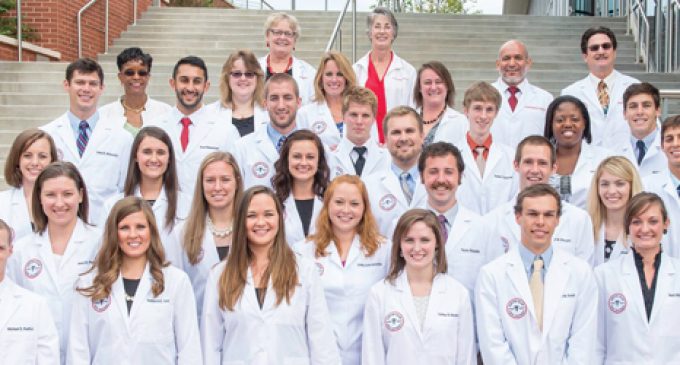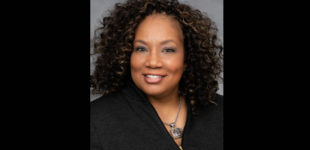PT working on diversity

(pictured above: WSSU Photo WSSU DPT students pose after their recent White Coat ceremony.)
The lack of African Americans in Winston-Salem State University’s three-year-old Doctor of Physical Therapy program caused a bit of an online stir last week.
The school posted a photo of its current class taken at a “white coat” ceremony to its Facebook page last week. Of the 25 students in the class, there is one black female, a Hispanic male and a student who identifies as “bi-racial,” according to the school.
Responses to the photo ranged from “Wow! Interesting” to “Why are all the faces white, but all the athletes (are) black?”
Dr. Peggy Valentine, dean of the School of Health Sciences, said that the department has recognized the decline in diversity. She said the Physical Therapy Centralized Application Service, or PTCAS, used by the school doesn’t allow it to zero-in on black students. With the system – a service of the American Physical Therapy Association – applicants can apply to multiple programs across the country with one application.
“We are thinking that part of it is due to the (PT) CAS system. It is a centralized admission pool,” Valentine said. “We have noted that fewer African Americans are applying to these doctoral programs, not only at WSSU, but nationally.”
Ayana Graham is the black student in the program. She said when she started, she, too, was surprised by the lack of racial diversity.
“A lot of people were expecting, because WSSU is an HBCU (historically black college/university), that there would be more black people in the class. My first day, I thought there would be, too,” Graham said. “I wish there was more representation in the class, but that is something that our chair (Dr. Lynn Millar) is working on to increase.”
Graham said funding may be a barrier for some minorities. The program costs about $60,000, and the school does not offer scholarships to students in the program.
“It is difficult (to pay for school), but I have a loan where I have to work in my field at least three years in North Carolina, and I can get up to $56,000 towards my loans,” she said.
The 24-year-old said she readied herself for the rigorous and competitive program by seeking assistance from School of Health Sciences personnel during the application process.
“I took advantage of resources at the school, and the faculty helped me make sure my application looked as good as possible,” she said.
Valentine said measures are in place to try to increase the program’s diversity.
“The faculty is very aware that we must increase diversity. We are working with the exercise physiology program on campus, which I think is over 80 percent African American, and those two departments are working together to facilitate entry of WSSU students into the DPT program,” she said. “We are expecting that next year we will have a curriculum so that a junior student can transfer directly into the Physical Therapy program as long as they meet the grade point average and GRE (Graduate Record Examine) score requirements. They can get their doctorate of physical therapy very quickly.”
The department has also reached out to other HBCUs – Bennett College and Delaware State among them – to pique the interest of students there. But recruiting students from out-of-state, especially, could be problematic, as they would have to pay much higher tuition at a state school like WSSU.
Valentine says there is also a public relations aspect to drawing more minorities. Many students of colors are focused on nursing and medical schools. Few consider the burgeoning physical therapy field.
“Nationally, the representation of African Americans in the physical therapy field is less than 5 percent. We believe that if Historically Black Colleges and Universities such as Winston-Salem State University don’t make this happen … that the representation may be even worse,” Valentine said.
The DPT program is not alone. The school’s Occupational Therapy program has also experienced a decline in diversity. Valentine said that the school is working just as hard to increase diversity in that program.
“The last count for the new class just came in. Out of 26 students, I believe the chair was telling me that there were six students who were students of color, four being African American, one Hispanic and one Asian student,” she said.
Half of the student body of the school’s traditional nursing program, the largest program in the school of Health Sciences, is African American.
Graham said her class is a tight-knit group and that racial barriers don’t exist.
“We hang out and do things after class, fun things and different events at people’s homes,” she said. “I don’t feel isolated or feel like people don’t want to study with me. Some jokes I don’t understand but apart from that, everything is good.”













